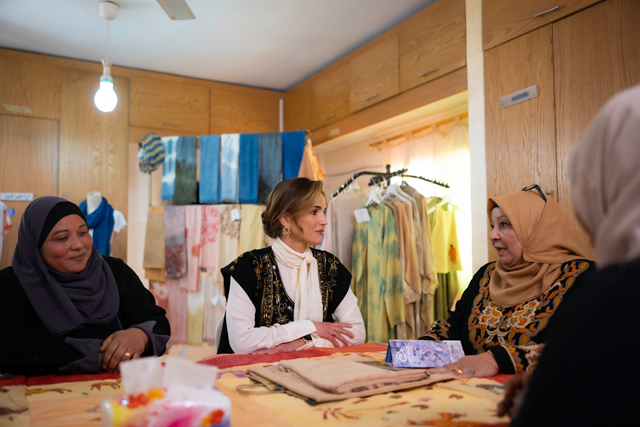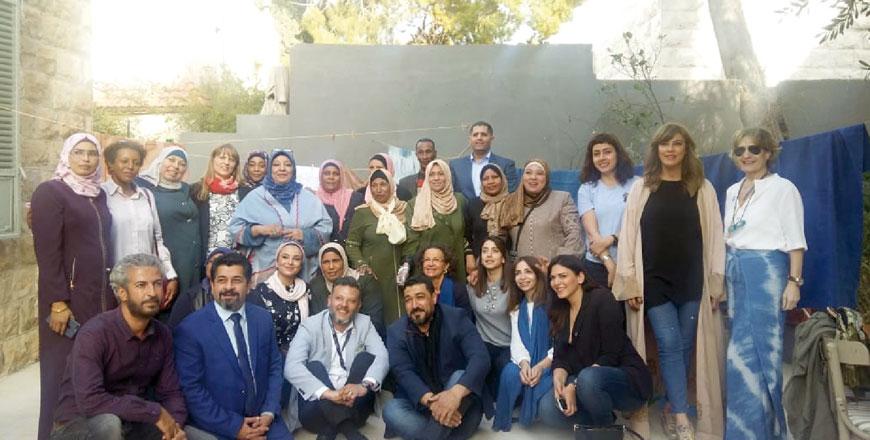You are here
Indigo natural dye colours lives in Ghor Safi
By Camille Dupire - Jun 21,2018 - Last updated at Jun 22,2018

A woman works in the indigo plant fields in Ghor Safi area recently (Photo courtesy of UNESCO)
AMMAN — As most dye used for our daily life products have become synthetic, natural dye from Indigofera tinctoria (also known as “true indigo”) are still available, thanks to the dedicated efforts of some local communities like the women of Ghor Safi.
Since 1999, Safi Crafts, which was founded by the “Ghor Safi Women’s Association for Social Development”, has become a thriving handicraft business, which supports some 14 women in the southern area of Jordan.
With support from UNESCO and funding from Drosos Foundation, the local women’s cooperative has been working to improve the lives of Ghor Safi residents by enhancing the production and promotion of their hand-dyed textiles using naturally sourced elements.
“In 2014, the women reintroduced the cultivation of the indigo plant in Jordan after the Ghor Safi area had been famous for the production of ‘Indigofera Tinctoria’ in the early Islamic period,” a UNESCO official told The Jordan Times, adding “the cultivation of the valuable plant had however gradually disappeared”.
With an initial batch of indigo seeds purchased from India, the first indigo crop was harvested in November 2014. Since then, each year during harvest, the seeds are extracted from the plants and saved for the following year, making the production sustainable, the members of Safi Crafts explained.
“If there was no ‘Safi Crafts’, I would probably just be sitting under a tree, drinking tea,” said Nada, who oversees the initiative’s IT and finance.
Nada is one of the 14 members of Safi Crafts, who are each attributed to a specific role ranging from human resources representative to IT and finance officer and manager of production.
For other members, the inclusivity of the association is what they enjoy the most. “Before Safi Crafts, I had never worked in a team before. Now, I work with 13 women. It has given me a sense of belonging,” shared Arwa, another member.
The women’s valuable dye have now become the association’s most prized dye, as it produces a “deep and vibrant blue” that the women enjoy experimenting with, producing various intensities and styles.
“Through experimenting, we have learned that when we combine indigo with other naturally derived dyes, we can create new shades. For example, pomegranate and indigo mixed together make green,” explained Umm Mohammad, the head of the association, adding “in the beginning, we had a limited colour scheme; adding in indigo has helped us to develop five new shades”.
This year, the women also discovered how to produce black for the first time, mixing together pomegranate, iron and indigo.
But working with Indigo is not easy, stressed Mervat, who said “indigo is fickle and affected easily by temperature. When processing the plant to make the dye, the temperature of the water must be closely monitored. A change of a few degrees can throw off a whole batch of dye, affecting the quality of the colour”.
The process of dying indigo is also very thorough, requiring constant attention from the producers. “Once the crop has been harvested, large barrels are filled with water, which is allowed to heat up in the sun, at a specific temperature. The plants are then placed in the barrels and then moved to another barrel in the shade,” a member called Nour explained, adding, “then, another herb is added to the barrel to bring down the indigo: it is like chemistry.”
Once this has soaked for one day, the dye is filtered again into a further set of barrels and the plant material is removed. The precious dye is then finally ready and vivid scarves, dresses, caftans and pillowcases are created, often in a tie-dye pattern to emphasise contrast.
The women of Safi Crafts are now very optimistic about their future prospects, as the Ministry of Agriculture recently granted them a five dunum plot of land free of charge for the next five years.
For Mervat, being able to work in the special niche that indigo represents is “really exciting”. “Indigo is the only plant that can create a true blue colour, organically. And we are the only people who work with indigo in Jordan which makes it also truly unique,” she underlined.
Since its inception over 70 years ago, UNESCO has been a leader in efforts to support women’s rights, empowerment and gender equality. The agency is committed to increasing rural women’s employment opportunities in line with the belief that no society can develop sustainably without the active participation of women, according to a statement by UNESCO, which outlined its support to gender equality in line with the implementation of the 2030 Agenda for Sustainable Development in Jordan.
Related Articles
Three experts from Oman concluded a five-day visit to Jordan on Thursday during which they shared their expertise on the ancient tradition of indigo harvesting, processing and dyeing with members of Ghor El Safi Women’s Association, according to a UNESCO statement.
AMMAN — Her Majesty Queen Rania visited Ghor Al Safi in Karak Governorate on Wednesday, where she met with Ghor Al Safi Women’s Association
AMMAN — Under the patronage of Social Development Minister Basma Ishaqat, the Drosos Foundation and UNESCO Amman on Thursday launched the Sa













